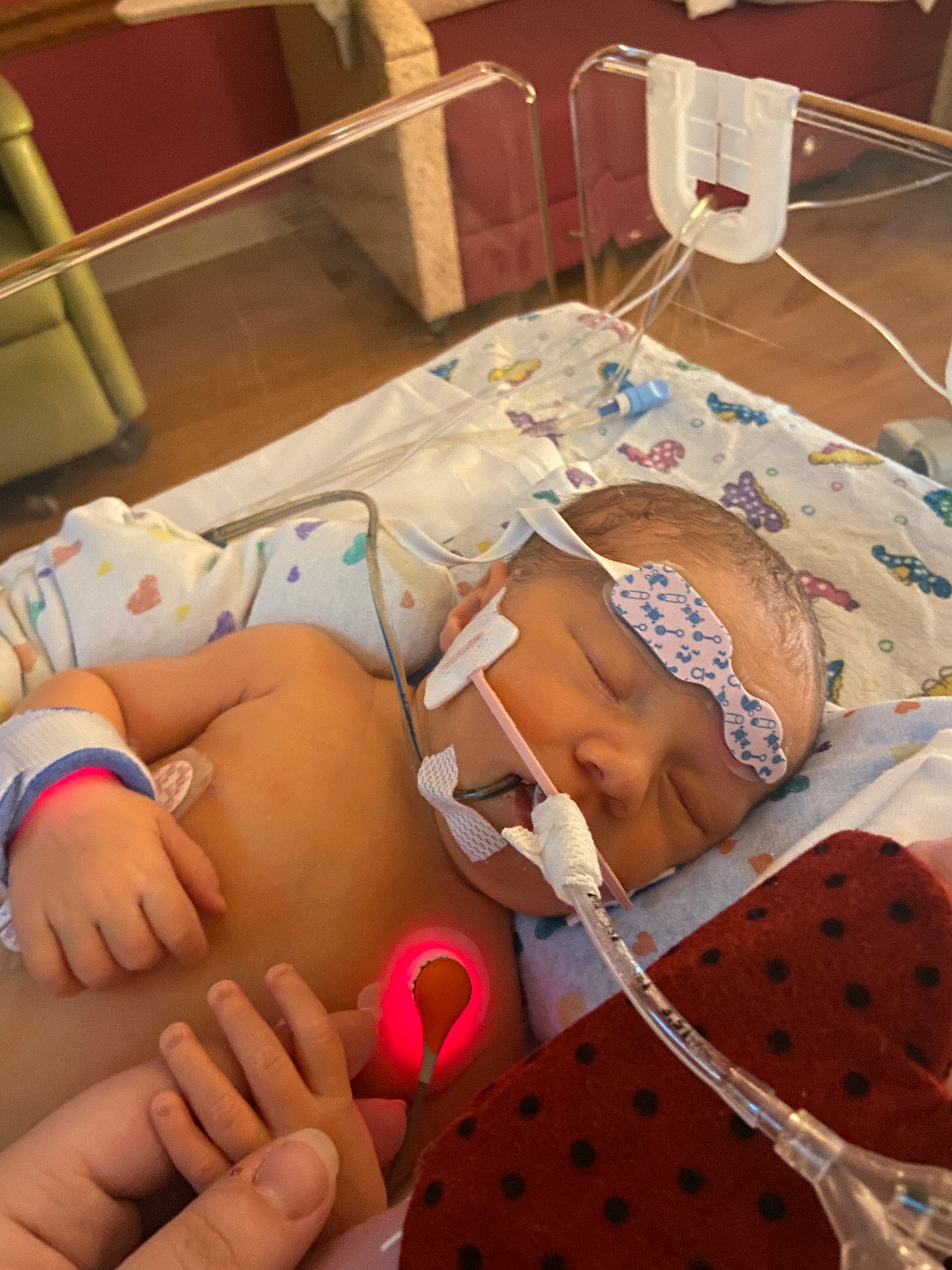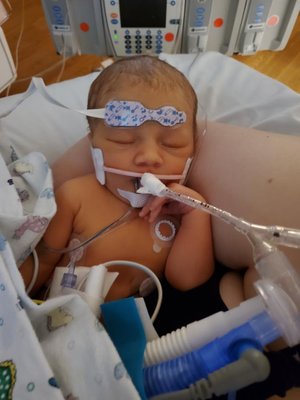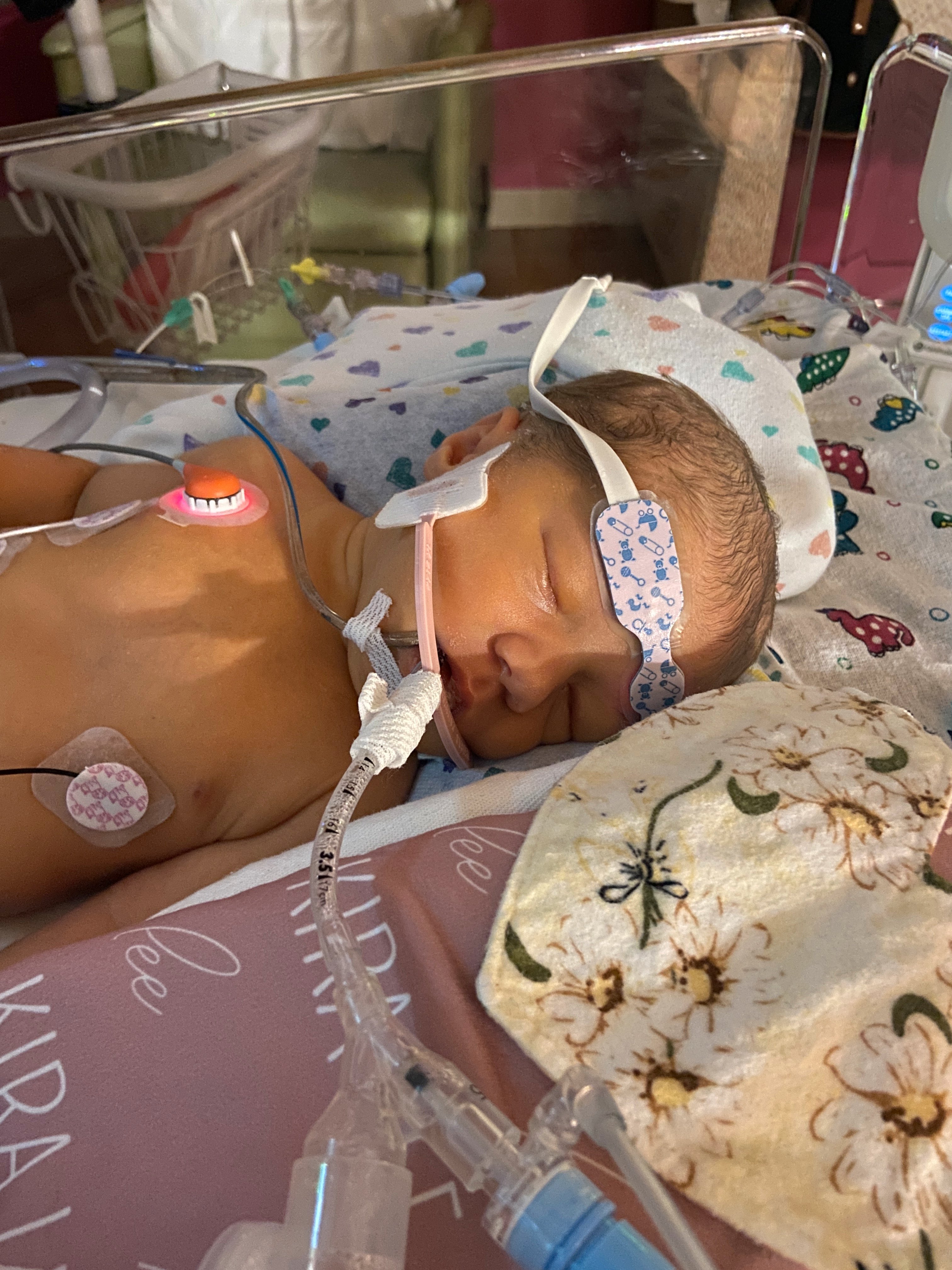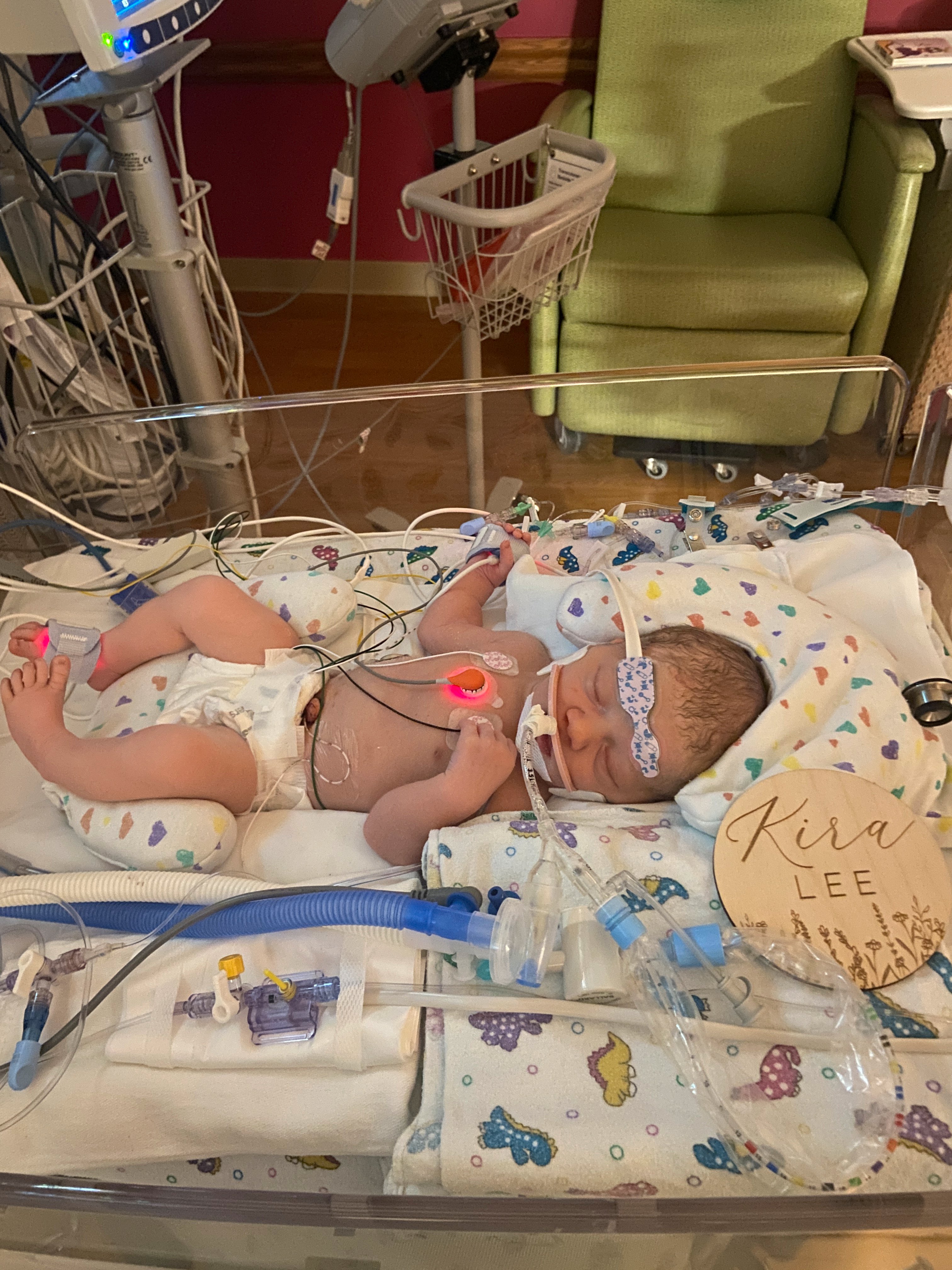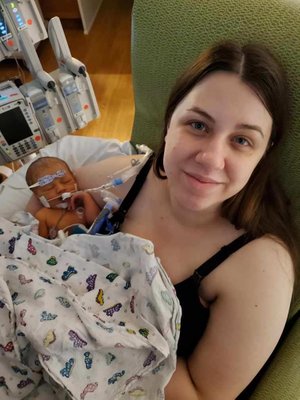Journal entry by Alisha Schoenbeck —
Kira Lee Schoenbeck made her appearance in the world on May 31st at 2:44pm. At 37.3 weeks gestation, she clocked in weighing 6lbs 5oz and measuring 19.5 inches long. She arrived after 34 grueling hours of labor but only 45 minutes of pushing. She cried at birth, and it was amazing to hear her tiny voice. She was even placed on my chest after delivery for about 30 seconds, which was an experience I had not expected to have. Seeing her eyes open and hearing her cry on my chest for that brief time was an experience beyond words. The NICU team was present at delivery, and Kira was promptly taken to the radiant warmer in the corner of the room to be intubated after 30 seconds of skin to skin contact. Matt was able to follow her to the NICU to briefly see her off, and I was able to go see her several hours later after my epidural had worn off.
On a related side-note; throughout my pregnancy, Matt and I have felt a strange pull toward bunnies as we decorated the nursery and bought things for the baby. My mom had gifted us a stuffed bunny toward the start of my pregnancy and Matt and I often talked about this becoming Kira's "lovey". We bought several bunny-themed toys and clothing items and in the last weeks of pregnancy, would joke with each other that we were developing a sort of "bunny theme" for Kira, and that something about the thought of her and bunnies just felt right. The CHOW NICU is divided into various wings, each of which is themed after a different animal. As the NICU team wheeled Kira down the hall that afternoon, Matt informed me that they briefly paused between the different wings before turning and wheeling her into the "bunny wing" of the NICU. Maybe it is just coincidence, but I have a feeling that this is the universe sending us a sign. Now, a mural of bunnies hangs above Kira's radiant warmer in the bunny wing, and her bunny lovey sits on the shelf of her NICU bed to watch over her.
Kira looked very good at birth; she required low settings on the ventilator and had a good initial blood gas after birth, which the team had previously told us was a strong prognostic indicator. She looked so good initially that the surgical team approached us shortly after her birth and told us they planned to perform surgery on Friday morning, less than two days away. However, it is common NICU knowledge that babies often have what is referred to as a "honeymoon period" where they do very well for 12-24 hours before having a subsequent decline before they ultimately stabilize. The day after her birth, Kira continued to do well. However, that evening, she had an episode where she had a sudden decline in her oxygen levels and was unable to recover from it. The team ended up disconnecting her ventilator from her breathing tube, deep suctioning it, and were able to get a large mucous plug out which had been blocking her tube. However, after this episode, Kira required increased oxygen levels and ventilator settings for the next day, and the plan for surgery on Friday was scrapped.
There is not a hard or fast rule with how quickly surgery is performed on babies with CDH. Back in the day, babies were operated on immediately after birth, because it was believed that the repair needed to be done as quickly as possible for the best chance of recovery. However, studies have shown that the timing of surgery does not change outcomes for CDH babies. Instead, the approach nowadays is to wait until the baby is stable and doing as well as possible. Taking the baby into surgery when they have stabilized and are in a good place gives them the best chance of being strong and recovering from surgery. It is a game of patience, and with that in mind, waiting on surgery was the best thing for Kira at that time.
With that said, the team informed us that they would reschedule her surgery for early the following week with the understanding that Kira do well through the weekend. Thankfully, Kira obliged, and over the next several days, steadily decreased her oxygen requirements and ventilator settings. She is currently on primarily 21% oxygen (the same oxygen percentage in the room air we all breathe) and fairly low ventilator settings on a conventional ventilator (as opposed to the higher-acuity oscillator ventilator). Her blood gases, and specifically CO2 levels, have remained stable. Other vital signs, including her blood pressure, have been good as well. She is on several medications to sedate her so she does not fight the ventilator, as this is something she was doing during those initial few days which caused an increased work of breathing and worse oxygen levels. Her echocardiogram (heart ultrasound) shows signs of pulmonary hypertension, which is completely expected with her diagnosis, but there are no additional alarming findings or defects, and special monitoring of her oxygen levels to keep an eye on the degree of pulmonary hypertension have been primarily normal.
Though we have not seen her open her eyes since birth, we have seen her move her legs and arms, and even suck on swabs of my breast milk while sedated, which has been wonderful to witness. She is currently getting all her nutrition through special umbilical and IV lines and is unable to take anything by mouth. However, I have been working on pumping to establish a milk supply so I am ready to feed her when she is ready to learn to eat. The highlight of our weekend was definitely getting to hold our daughter for the first time. This is something we had been unsure if we would be able to do until sometime after surgery. We had been told that some babies are stable enough to hold before surgery while others are too sensitive or unstable. Thankfully, Kira was deemed stable enough to attempt to hold. On her second day of life, I was able to hold her for the first time with the assistance of an amazing team of nurses and respiratory therapists. I can confidently say this was one of the best experiences of my life. Matt was able to hold her for the first time today and expressed similar feelings. Holding her was especially meaningful as after surgery, it is likely she will be too sick and/or have too many lines to be able to hold again for some time.
Kira's surgery to repair her CDH is officially scheduled for Monday (tomorrow) morning. There are two approaches to repair- a thoracoscopic approach (where small incisions are made and cameras are used to perform the repair) or a traditional open approach (where the abdomen is cut open). The surgical team is hopeful that they can use a thoracoscopic approach to repair Kira's CDH, but ultimately, may have to do an open repair depending on what they find once they start surgery. The other question is whether they are able to do a primary closure (sewing the open areas of her diaphragm together) versus needing to use a patch if the defect is too large; kids with primary repairs tend to do better and have less long-term issues than if a patch is used. It is impossible to know the exact size or type of defect she has until they perform surgery. Thankfully, X-rays have continued to confirm what was suspected on fetal ultrasound; that Kira's small intestines are the only organ which have herniated up through her diaphragm. X-ray shows that both her liver and stomach are still below her diaphragm, which is good from both a prognostic and surgical standpoint.
After surgery, we have been told to expect Kira to get sicker before she begins to get better. After surgery, her left lung will inflate and her heart will shift back into its appropriate position. The hemodynamic and fluid shift these changes cause in the body can result in hypotension as the body adapts. Furthermore, Kira will need to be on continued IV sedative medications along with a paralytic (medicine that makes her unable to move) and pain medications. It is important that she remain still, calm and sedated after surgery so her incision can heal while optimizing her pain control. In terms of her ultimate lung function, this is also impossible to know until surgery is performed and time has passed. The team is hopeful for her lung function, as they can see a bubble of left lung tissue on X-ray, and as previously noted, her defect was detected so late in pregnancy. The hope is still that her lungs had sufficient time to develop before being displaced. There is no hard and fast timeline for how quickly she will recover; every baby responds differently, and we will need to be patient as we wait and see how she does after surgery.
One certainty in all this is that Kira is a brave, strong girl. She has gone through more in her first four days of life than many people do in a lifetime, and despite this adversity, she is doing so, so well. As we head into surgery tomorrow morning, all continued positive thoughts and well wishes are appreciated for a successful, uneventful surgery and a full, quick recovery afterwards.
-
Help Alisha Stay Connected to Family and Friends
A $25 donation to CaringBridge powers a site like Alisha's for two weeks. Will you make a gift to help ensure that this site stays online for them and for you?
Show Your Support
See the Ways to Help page to get even more involved.


